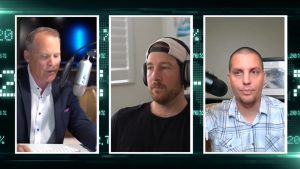
Since 2022 started out with one of the biggest headlines of recent years—that a surgical team transplanted a genetically engineered pig heart into a living person—we can be forgiven, perhaps, for expecting that there will be many more astonishing things to happen on the neobiological frontier in the coming 12 months. So what will they be? We turned to some of the visionaries and innovators who normally help us see deeply into the future and asked them to make some predictions about the next 11 months.
Our question was simple: What is the most exciting, impactful, or scary development you’re anticipating in 2022 in your field? We’re blown away by their responses. They made some truly bold predictions, many of which you will nod along with, but some of which will surprise you. And some of them, frankly, will probably turn out to be incorrect. But that’s the fun of predictions. Maybe next year we’ll do this and start a betting pool with crypto.
We took inspiration from Noubar Afeyan, the remarkable CEO and founder of Cambridge, Massachusetts-based biotech investment firm Flagship Pioneering, whose portfolio of companies includes Moderna, where he is also chairman of the board. His 2022 (and beyond) seems razor-focused on programmable medicine (“drugs as instructions, or programs, with predictable outcomes”) and digital biology (which means translating complex biological problems into computational ones). After a remarkable year for the mRNA vaccine and platform, Afeyan wrote, “The era of programmable medicines has given all of us in the field—scientists, entrepreneurs, inventors, and investors—permission to leap.”
The big leaps coming in 2022
The first person we started with is Chris Mason, whose book The Next 500 Years: Engineering Life to Reach New Worlds was published last year by MIT Press. He does cool things like sampling the DNA all around him to create the world’s first genetic map of a city. And he ran NASA’s biomedical study comparing spacefaring astronaut Scott Kelly’s health with that of his Earth-bound twin brother Mark. Mason is also an associate professor of biophysics, computational genomics, and neuroscience and the director of the WorldQuant Initiative for Quantitative Prediction at Weill Cornell Medicine, whose mission is to develop predictive tools for advancing precision medicine.
Mason was probably amused by the chance to think so short term, and he had some exciting developments to highlight. In a major milestone for genetic engineering, he pointed to the thousands of people who will be emerging from clinical trials this year after having had their genomes edited, and he’s expecting some of them to have been cured of the common genetic blood disorders sickle-cell anemia and beta-thalassemia.
He’s watching continued large-scale genome synthesis, which he predicts will make headlines this year, and he also points to the storage of information in DNA as a field that’s due for a breakthrough. Mason is particularly bullish about what we’ll learn from large-scale efforts to map and track viruses and other emerging pathogens from sewage, air, and city surfaces, as well as human samples from around the world. And in off-world developments, he’s excited about the Perseverance Rover, which landed last winter in the Jezero Crater on the surface of Mars. Mason predicts it will collect up to 30 samples of air and soil this year, furthering the potential for future human exploration and/or colonization of Mars. He also anticipates that the newly launched James Webb telescope will soon discover thousands of additional exoplanets, with dozens likely in the habitable zone. Humanity’s new home someday?

Genetic engineering and genetic counseling
We challenged another well-known, long-term thinker, the Harvard biochemist and geneticist George Church, who admits to not being particularly skilled in the 12-month time frame, but blames that at least in part on the 10+ years it generally takes to get medical breakthroughs through the U.S. Food and Drug Administration approval process. Nevertheless, with the record-setting pace of accelerated approval for all the coronavirus drugs, vaccines, and medical devices, things could be changing.
Church points to factors that helped make such a success of three of the top COVID-19 vaccine technologies. For one thing, they all used gene therapy technologies, and each was a new method relative to the past and to each other. For instance, the AstraZeneca vaccine was based on an adenovirus capsid containing double-stranded DNA as opposed to an adeno-associated virus (AAV) of the Johnson & Johnson/Janssen vaccine, while the Moderna and Pfizer/BioNTech vaccines were based on single-stranded mRNA inside lipid nanoparticles.
“Implementation science is the unsung handmaiden of biomedical discovery!”
Secondly, each of them was approved by the FDA 10 times faster than the vast majority of therapeutic products, and finally, the cost per vaccine has been as low as $2 per dose for the United Nations’ COVAX global access program. That’s about a million times cheaper than Zolgensma, he says, referring to the AAV gene therapy medication used to treat spinal muscular atrophy. So since “any one of these could spark a revolution,” according to Church, imagine what could happen in the next 12 months if all four factors pertain again?
He also ventures a second prediction: the rise of genetic counseling, which is something he thinks “could happen any day (or never).”
“Widespread premarital genetic counseling [akin to Dor Yeshorim, the nonprofit also known as the Committee for Prevention of Jewish Genetic Diseases] would have a trillion-dollar impact on health care, yet be essentially risk-free and unregulated—and rightly so.”
When it comes to genetic counseling, we were dismayed to read the study published in JAMA last week that reveals how infrequently patients with ovarian cancers are getting genetically screened for BRCA markers these days, in spite of universal testing for those women being a medical recommendation issued 11 years ago. So we asked Robert Green, the Harvard geneticist, Brigham and Women’s Hospital physician, and founder of the MedSeq project. Should we expect any changes in the movement of genomic counseling from the lab to the bedside this year? He says it’s just one piece of a bigger puzzle in how to implement advances.
“Until someone figures out how to muster the combination of evidence that can convince the medical establishment to adopt new technologies and engineers the logistics to put new medical workflows into place, the discoveries cannot reach their potential for transforming human health,” he says. “Implementation science is the unsung handmaiden of biomedical discovery!”
Nevertheless, he does predict 2022 will be the year that preventive genomics goes mainstream. “The COVID-19 pandemic has been the public health emergency of our lifetimes, but behind the scenes, evidence has been gathering to fight the slower-moving pandemics of cancer and heart disease through genomic medicine,” he says. “In 2022, we will see widespread implementation of ‘precision public health,’ using DNA analysis in the general population to stratify disease risk and concentrate resources to save the lives of those at greatest risk.”
He also predicts a tipping point for widespread neonatal DNA sequencing this year. “In 2022, the explosive progress in gene-editing and gene-targeted therapies for inherited conditions presenting in infancy will form an irrefutable rationale for offering genome sequencing to healthy newborns at scale,” Green says.
Longevity’s short list
Experts working in the field of longevity are equally hopeful that 2022 will unleash new discoveries and remove roadblocks. Harvard professor David Sinclair anticipates, “Tens of billions of dollars will be invested in longevity research in a race to find molecules that reverse age.” And he predicts that in 2022, “the first drug to slow aging will enter the final stage of human clinical trials,” which he said could be an NAD booster (which is in phase 2) or metformin or a senolytic.
“We should see the first hit or hit-to-lead molecules discovered using the AlphaFold structures”
We also turned to Alex Zhavoronkov, the fast moving, news-generating founder of the Hong Kong-based biotech Insilico Medicine, a new kind of pharma-tech hybrid using AI to discover new drugs in silico. He predicts “another year of records” in terms of AI-powered drug discovery, which he says will demonstrate better speed, cost, and probability of success when compared with traditional approaches, and he anticipates that more companies will build AI-driven, fully automated robotics labs.
Zhavoronkov sees 2022 as a major proof-of-concept year for protein folding predictions. “The first hit (or hit-to-lead) molecules will be discovered using the AlphaFold structures,” he says. He also points to the rise of quantum computers, which will help in this effort. “Molecules will be generated on quantum computers or simulated quantum computing platforms” this year, he says.
Like Sinclair, he expects to see a lot of corporate activity in the longevity space, predicting at least 10 more companies launching that will use AI for both regenerative medicine, gene therapy, and the traditional small molecule approaches. But he’s also anticipating that Google and other big tech companies might finally announce some results. “Google Calico officially launched in September 2013 and ingested billions,” he says. “I would be surprised not to see a drug in the clinic in the ninth year of their existence.” On a related note, he suggests we should keep an eye on pioneering AI researcher Demis Hassabis, CEO and cofounder of DeepMind, who has “already started delivering very useful solutions.”
And finally he commented on aging clocks, predicting that they will become even more mainstream. “We will see at least one life insurance company start using biological aging clocks with their clients, and the first credible clinical trial supported by a biological aging clock will be launched,” Zhavoronkov says.
Bring it on!
From brain–computer interfaces to psychedelics on the mind
Speaking of bringing it on, we caught up with neuroscientist entrepreneur Ana Maiques at her home in Barcelona to get her thoughts on what 2022 might bring in terms of headlines or surprises in the world of brain–computer interfaces. Her company, Neuroelectrics, has been working on Neurotwin, a 48-month project to develop a cloud-based model of a human brain and its data generated through non-invasive electrical brain stimulation for treating various brain disorders. The goal is to refine this model in order to predict and design future therapies. She points to the explosion of innovation in terms of non-pharmaceutical approaches for dealing with brain diseases.

“We gave the drug companies 50, 60 years and they failed,” she says. “Of course, they made some progress, but we’re starting to see the limitations of that approach, and there are still millions of patients suffering with no effective treatment.” According to Maiques, advances in the use of therapies involving light, sound, and electrical impulses are all going to make headlines in 2022, providing further proof and evidence for non-invasive, non-chemical interventions in brain disease.
And that’s before we even start talking about psychedelics, which is of course one of the most red-hot areas to be tracking this year—as much for the advances in science and clinical trials as for the breakthrough business opportunities, with market growth expected to clock in at a compounded annual growth rate of 14.5 percent for the next few years.
Not all this growth is potential, of course. The field of psychedelic medicines is awash in new companies and investment dollars, with lots of newcomers, but also major biotech and pharma companies as well as Silicon Valley tech VCs like Peter Thiel’s Founders Fund. The journal JAMA reported this week that as of January 2022, there were more than 50 publicly traded companies in this space, with at least three European players valued at more than $1 billion—ATAI Life Sciences in Berlin, Compass Pathways in London, and GH Research in Dublin. New York-based Mind Medicine is also knocking on that door, valued at $924 million as of late last year. And that’s not including all the philanthropic dollars coming from people like Tim Ferris, who says he has contributed over $4 million to psychedelic research.
So we called Natalie Ginsberg, the Global Impact Officer of MAPS, the Multidisciplinary Association for Psychedelic Studies, where she lobbies in support of cannabis and psychedelic research and policy change. A former social worker in New York City, she is also involved in developing a psychedelic peace-building strategy between Israelis and Palestinians. Ginsberg predicts that “California will decriminalize psychedelics in 2022 which means it will pass SB Senate bill 519 introduced by Senator Scott Weiner from San Francisco,” she says. “It’s a really exciting bill including MDMA, ibogaine, ayahuasca, a whole range of psychedelics, which is very interesting.” She went on to express the hope and conviction that eventually more places would follow in Oregon’s footsteps by decriminalizing all drugs—but not in California this year.

A similar, global initiative was launched this month (in partnership with MAPS) calling for a reconsidering of psilocybin’s current, most restrictive schedule 1 controlled substance status under the United Nations’ 1971 Convention on Psychotropic Substances. Schedule 1 status is intended for truly dangerous drugs that pose a serious risk to public health and offer little to no therapeutic value, and it creates added cost, complexity, and delays to the research and approval of psilocybin-based treatments, says Christopher Koddermann, the cofounder and chair of the new International Therapeutic Psilocybin Rescheduling Initiative.
As for what specific result the initiative hopes to achieve, Kodderman said to NEO.LIFE in an email earlier this month unrelated to this story, “I believe that a move beyond schedule II is probably unrealistic at this stage. However, just getting psilocybin out of schedule I would be a massive victory.”
“More people will have access to ketamine-assisted therapy, integration, and support.”
Ginsberg also points to the rapid expansion in the number of ketamine clinics, where psychedelic-assisted therapy is available and legal, however the majority of clinics around the U.S. are only administering the ketamine itself, and do not offer therapy adjuncts. Confident that 2022 will bring a new wave of trained psychedelic therapists who will start working with ketamine, Ginsberg says, “more and more people will have access to ketamine-assisted therapy, integration, and support.”
She says that as the pandemic persists, mental health continues to be a distressing issue, prompting people to look at different alternatives and new options for treatment. Of particular interest to her are the studies and groups being formed to try to understand how psychedelics could be used to help in conflict resolution and dialogue work and in healing climate- and eco-grief. “There are a lot of beautiful use cases for group work,” she says. Some of these are focused on addressing systemic and historical forms of violence, and others seek to use the treatment to foster dialogue and understanding, “as part of these healing processes,” she adds.
But what is going to move the needle on psychedelics this year will be clinical trial results. Berra-Yazar Klosinski, the chief scientific officer of MAPS says they’ll begin enrolling participants for their phase 2b trial of cannabis for the treatment of PTSD and will complete the enrollment of the second, confirmatory phase 3 trials of MDMA-assisted therapy for PTSD.
Synthetic biology and focused ultrasound
What about synthetic biology? We asked Emily LeProust, the CEO and founder of South San Francisco-based Twist Bioscience for her thoughts. We thought she might talk about data storage using DNA (which she initially offered as an exotic idea for a holiday gift for NEO.LIFE’s first annual gift guide). Ever since selling ten million long oligonucleotides to Microsoft to encode digital data back in 2016, we’ve been curious about when this market will really take off. And they reportedly hit a new technical milestone last year by miniaturizing the components to a degree that allows them to now store the DNA on gigabyte-class chips rather than megabyte-class chips.
Instead, she says, “We are hearing a lot about how carbon is the enemy, when in reality, carbon needs to be in the right place, as carbon is instrumental to many positive biological processes,” she says. “In 2022, building on the momentum of the work in late 2021 in which scientists developed synthetic metabolic pathways to convert carbon dioxide to starch, I believe that the synthetic biology community will continue to advance solutions that can place carbon in areas where it can do good by enabling new materials and chemicals, rich crops, healthy ecosystems, and vast forests rather than simply trying to eliminate it from our world.”

In other words, they have plenty of big fish to fry. Now we just need to figure out how to efficiently scale the process to satisfy global supply chains.
After discovering the wonders of focused ultrasound for not only diagnostics, but now treatment, we wanted to check in with Neal Kassell, the founder of the Charlottesville, Virginia-based Focused Ultrasound Foundation (where I am a member of the Futures Council) to hear what he’s hoping to see happen with that technology this year. “As the field transitions from what historically has been primarily a research and development environment to the beginning of a commercial treatment environment,” he says, “I expect to see investments coming not just from traditional sources, such as venture capital, but also from strategic sources including medical device manufacturers, imaging companies, pharma, and biotech.”
“In fact,” he adds, “I imagine the first public company using focused ultrasound for treatment will reach unicorn status.”
You read it here first!
The China question
Against the backdrop of a U.S.–China trade war, Chinese biotech innovation looms large over the life sciences industry in the United States. We asked former immunologist turned biotech investor Chen Yu, a managing partner at TCG Crossover, to weigh in on what kind of innovation we can expect coming out of China in 2022. Taking the 30,000 foot view, he wrote that the most impactful thing “is not a [technological] advance at all but rather the assault on innovative capacity generally in the world’s two biggest economies.”
He cautions that the desire to reduce inequality could inadvertently remove fuel for innovation and risk taking. Pointing to the bipartisan consensus on reducing drug prices in the U.S. Congress, he questions what would happen without the profit opportunity current pricing levels afford, and says movement on this front in 2022 could put at risk the entire financing infrastructure for early-stage biologic development.
“Non-molecular approaches to treating brain disorders will be taken seriously based on robust data.”
“The second [prediction] is the geopolitical risk between the United States and China. China was the site of 30 percent of all biotech IPOs last year. Our [U.S.] research labs have, to date, been dominated by Chinese expats working as postdocs and faculty in U.S. academic institutions. As our countries decouple, that talent is returning to China, while we are simultaneously turning away from a core source of financing. At the same time, the inability of Chinese companies to access U.S. markets/capital will hamper their own ability to finance innovation as their government tightens regulation and drug pricing in even more draconian ways. So, in sum, the biggest impact to innovation is the regulatory and political barriers societies are erecting against innovative capacity itself.” For more on this situation, see our recent investigation.
And finally, we asked our friend Amir Kalali, a pioneer of drug development and life sciences innovation and founder and chairman of the CNS Summit, what he sees as he scans the horizon. His first prediction is that “non-molecular approaches to treating brain disorders will be taken seriously based on robust data.” Included among those approaches are neuromodulation utilizing electrical impulses as the currency of the brain, light, or sound. It will also include the innovative use of video games and XR (including virtual, augmented, and mixed reality) to treat neuropsychiatric illnesses and many other things.

Kalali’s second prediction dovetails interestingly with the first, which is that pharmaceutical companies and technology companies will begin to merge and that this year will see the first major acquisition that starts to blur the boundary between the two. We’re certainly seeing a dramatic ramp-up in the number of partnerships between AI companies and pharmaceutical companies for the purposes of drug discovery. We suspect some high drama will ensue as tech giants and drug behemoths come together and try to work out the balance of power between them. HBO’s hit show Succession may be over, but we see rich possibilities for a spinoff here.
And in terms of consumer-facing predictions, Kalali expects there to be a sprouting of main street brick-and-mortar retail outlets in cities across the world featuring self tracking/quantified self/aging trackers based on increasingly sophisticated quantitative biomarkers. That would certainly be a welcome development for the scores of startups spinning up apps to track your aging.
So there you have it—a snapshot of this moment in time, in between Omicron and the endemic or whatever new variant might rear its ugly head. Unfortunately, we’re pretty sure no one would question Kalali’s final prediction that we will continue to learn (or re-learn) the Greek alphabet as more COVID-19 variants emerge—to which we add “so long as none of the letters share the same name as China’s premier.”
And no matter who is right and who is wrong in our survey, 2022 will clearly provide a chance to get more science done.





No comment yet, add your voice below!